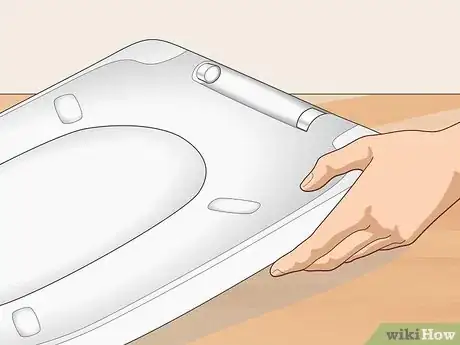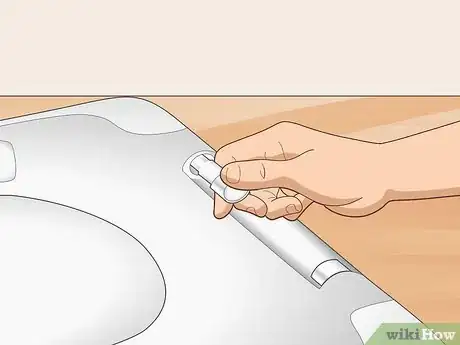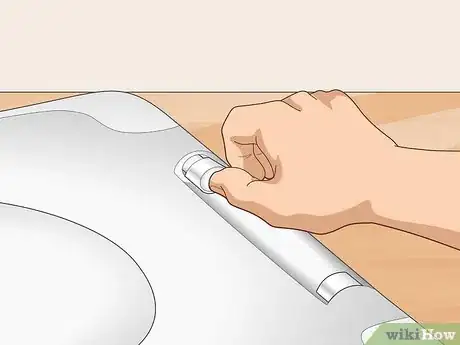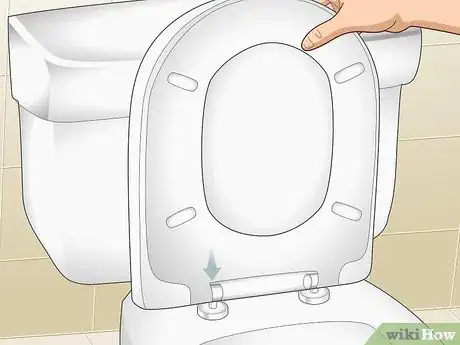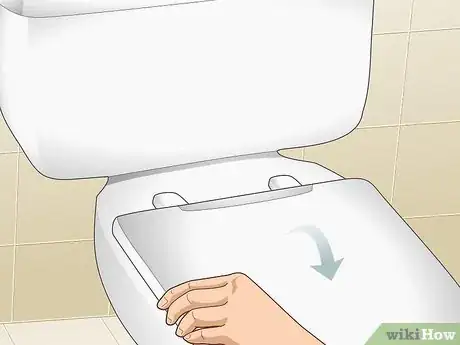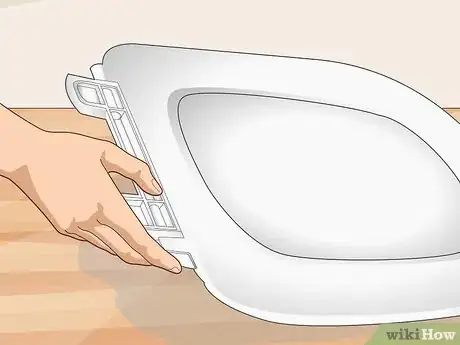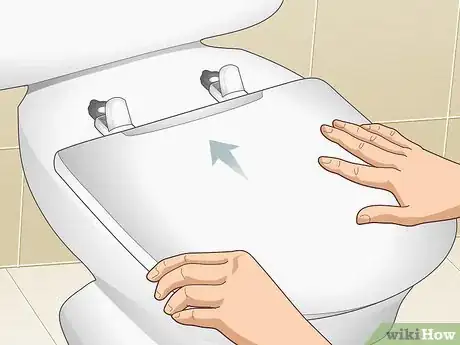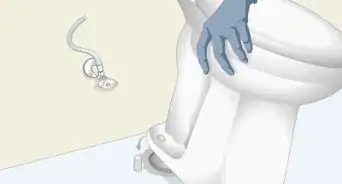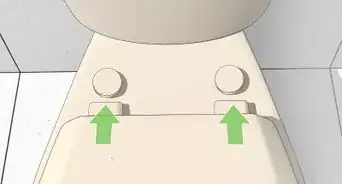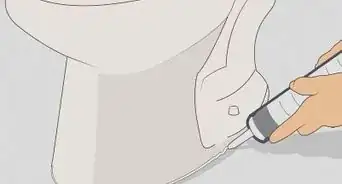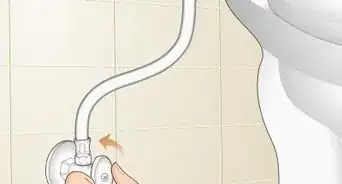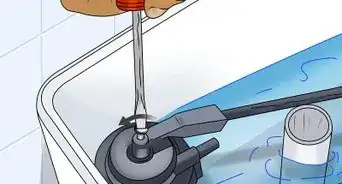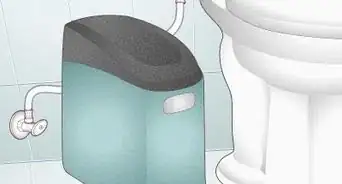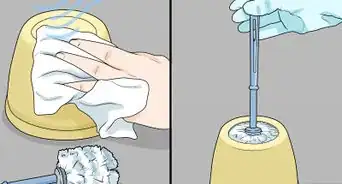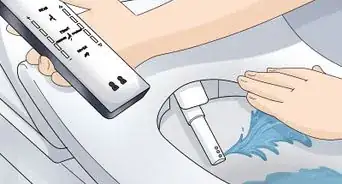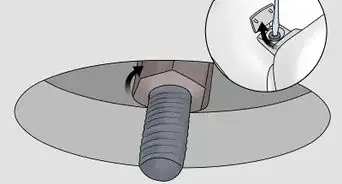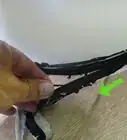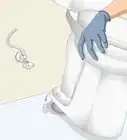This article was co-authored by Dave Jones. Dave Jones is a Professional Plumber and the Midwest Regional Vice President at Roto-Rooter Plumbing & Water Cleanup. In 1992, Jones joined Roto-Rooter as a drain service technician at the age of 18. Since then, he has risen through the ranks into positions of increasing authority. Dave served as general manager of Roto-Rooter’s Charlotte, North Carolina, and Atlanta, Georgia branches before being promoted to Contractor Area Manager and later to Regional Vice President. Dave holds Master Plumber Licenses in Pennsylvania, North Carolina, and Georgia.
There are 10 references cited in this article, which can be found at the bottom of the page.
This article has been viewed 328,383 times.
Soft-close toilet seats work because they have a special type of hinges that make the toilet seat close on its own very slowly and quietly. Some soft-close toilet seat hinges can be adjusted to make the seat close more slowly. However, not all soft-close toilet seats have adjustable hinges, but you’ll have to remove the seat and inspect the hinges to find out if yours are adjustable. If your soft-close seat isn’t working like it used to and you can’t adjust the hinges, you might have to fix it by replacing the hinge dampers with a new set.
Steps
Slowing Down Metal Peg-Style Hinges
-
1Open up your toilet seat and look for metal hinges that sit on vertical pegs. Metal peg-style hinges are 1 of the 2 main types of hinge assemblies that soft-close toilet seats may use. Look for metal pegs coming up from round plates attached to the back of the toilet bowl, which the hinges on the toilet seat slide onto.[1]
- If you don’t see this type of hinge assembly, your soft-close seat probably has a plastic clip-on type of hinge assembly.
Tip: If your toilet seat is loose, this doesn’t have to do specifically with the soft-close hinges. You can make adjustments to the bolts that hold the seat in place to fix a loose toilet seat, so it would not move back and forth. The only reason you would need to adjust soft-close hinges is if your soft-close seat is not closing at the right speed.
-
2Lift the toilet seat straight up off the hinges from the upright position. Leave the soft-close seat in the fully open position. Hold the seat at the top and bottom or at both sides and carefully pull it straight up off the metal pegs.[2]
- If your toilet seat doesn’t lift straight off, try tilting it forward just a few degrees and see if you can lift it off from that position.
- If you can’t slide the seat off the pegs, try pressing in the hinges with your thumbs and lifting it off. Different soft-close seats with peg-style hinge assemblies may have different locking mechanisms.
Advertisement -
3Set the toilet seat upside-down on a flat work surface. Flip your seat over so that the metal hinges are exposed. Lay the seat flat on a table or another flat surface.[3]
-
4Pull out the cylindrical dampers on both sides of the back of the seat. Grab the dampers between your fingers. Pull the cylinders all the way out of the holes they sit in.[4]
- These dampers are what actually control the speed at which the seat closes.
-
5Rotate the dampers towards the back of the seat to make it close more slowly. Spin each hinge damper towards the back of the seat, ensuring that you align the shape of the dampers with the shape of the holes that they slide into. This will slow down the seat’s hinges so they close it more softly and quietly. [5]
- Not all soft-close toilet seat hinges are adjustable. If there are notches on the dampers that make it so you can only take them in and out in 1 position, they are not adjustable.
- If your hinges are adjustable, they may be hexagonal or have multiple notches that allow you to put them in at different positions. They might also be labeled with “slow/fast” and directional arrows.
- Depending on the specific soft-close toilet seat you have, there might be 2-3 different positions you can set the dampers in to control the speed of the seat.
-
6Slide the hinge dampers back into the hinge assembly. Push the cylindrical damper back into the hole in the hinge assembly on one side. Repeat this for the damper on the other side.[6]
- If the soft-close dampers have multiple positions you can set them to for different speeds, double-check that you are putting them in at the same position on both sides of the seat. Otherwise, the seat and lid might close at different speeds.
-
7Put the toilet seat back on the toilet bowl. Align the holes in the seat’s hinges with the begs on the toilet bowl. Set the seat back on the hinge pegs in the upright position.[7]
- If the hinges have a locking mechanism, make sure you push the seat all the way onto the pegs until the hinges snap into place.
Making Adjustments to Plastic Clip-on Hinges
-
1Close the toilet seat and look for rectangular plastic covers at the back. Plastic clip-on hinge assemblies are the second main type of hinge assemblies that soft-close toilet seats can have. Look for rectangular plastic pieces that come off the back of the toilet seat, which cover the bolts in the toilet bowl that the seat’s hinges clip onto.[8]
- If you don’t see a plastic hinge assembly, your soft-close seat probably has metal peg-style hinges.
-
2Slide the seat forward from the down position to remove it. Leave the seat all the way down so that it is resting in the closed position on the toilet bowl. Flip up the plastic hinge covers at the back of the seat, then grasp the seat from the back and pull it straight forward off the toilet.[9]
- If you are unable to slide off the toilet seat, you might have to unscrew the bolts from underneath on the back side of the toilet bowl to remove it. Soft-close toilet seats with clip-on hinge assemblies can have slightly different attachment methods, depending on the specific make and model.
-
3Place the soft-close seat upside-down on a flat surface. Flip the seat over so that the hinge assembly is exposed. Lay it down on a flat surface with the hinges facing you.[10]
-
4Use needle-nose pliers to pull the cylindrical dampers out of the hinge assembly. Grasp the edge of 1 of the dampers between the pliers and pull to slide it out of the hole it sits in. Repeat this for the damper on the other side.[11]
- There might be a plastic cover on the underside of the hinge assembly that you have to pop off to see the cylindrical hinge dampers. If so, just pry it off with your fingers and set it aside. You might also be able to lift the whole hinge assembly out of the toilet seat to work on it more easily.
-
5Turn the hinge dampers towards the back of the toilet seat to slow it down. Rotate each hinge damper towards the back of the seat to make it close more slowly and quietly. Look at any notches or markings on the dampers and look at the shape of the holes in the hinge assembly to determine how far to turn the hinges to reinsert them at a new position.[12]
- If there are only 1 set of notches on the dampers or their shape makes it so that they can only be inserted into the hinge assembly in 1 position, they are not adjustable.
- Adjustable hinges are sometimes hexagonal or have different notches so you can insert them at different positions. They could also have directional arrows and be labeled with “slow/fast.”
- There might be 2-3 different positions you can set the dampers in to set the soft-close seat to different speeds, depending on the make and model of the seat.
Tip: If your soft-close toilet seat’s hinges are not adjustable, you can replace them with a new set, which costs less than $15 USD, to make your seat work like new again. You could also replace the entire seat for around $50 USD or less.
-
6Use your fingers to push the hinge dampers back into the hinge assembly. Insert the cylindrical damper back into the hole in the hinge assembly on one side in its new position. Do the same with the damper on the other side of the seat.[13]
- Make sure you’re putting both the dampers in the same position on their respective sides of the hinge assembly, or the seat and lid could close at different speeds.
- If you removed the hinge assembly from the seat or popped a cover off the hinge assembly, replace these at this time as well.
-
7Slide the toilet seat back onto the bolts at the back of the toilet bowl. Flip the toilet seat back over and set it flat on the toilet bowl. Align the clips at the back of the hinge assembly with the bolts on the toilet bowl, then push the seat until it clips all the way back on. Press the plastic covers back on top of the bolts.[14]
Things You’ll Need
Making Adjustments to Plastic Clip-on Hinges
- Needle-nose pliers
References
- ↑ https://homerepairgeek.com/define/slow-close-toilet-seat.html
- ↑ https://www.youtube.com/watch?v=PAtwFQ3FBzI&feature=youtu.be&t=4
- ↑ https://www.youtube.com/watch?v=exZUge_q6go&feature=youtu.be&t=34
- ↑ https://www.youtube.com/watch?v=6Tju1PweyG0&feature=youtu.be&t=36
- ↑ https://www.youtube.com/watch?v=6Tju1PweyG0&feature=youtu.be&t=40
- ↑ https://www.youtube.com/watch?v=6Tju1PweyG0&feature=youtu.be&t=40
- ↑ https://www.youtube.com/watch?v=6Tju1PweyG0&feature=youtu.be&t=50
- ↑ https://homerepairgeek.com/define/slow-close-toilet-seat.html
- ↑ https://www.youtube.com/watch?v=exZUge_q6go&feature=youtu.be&t=24
- ↑ https://www.youtube.com/watch?v=exZUge_q6go&feature=youtu.be&t=34
- ↑ https://www.youtube.com/watch?v=exZUge_q6go&feature=youtu.be&t=46
- ↑ https://www.youtube.com/watch?v=6Tju1PweyG0&feature=youtu.be&t=40
- ↑ https://www.youtube.com/watch?v=exZUge_q6go&feature=youtu.be&t=66
- ↑ https://www.youtube.com/watch?v=exZUge_q6go&feature=youtu.be&t=85


